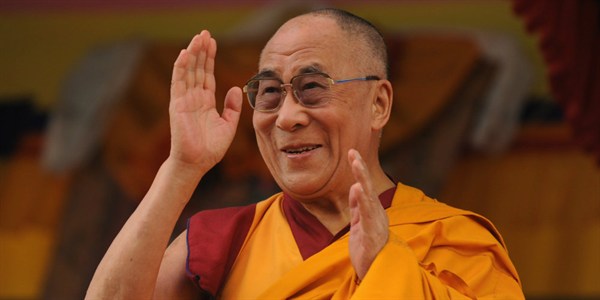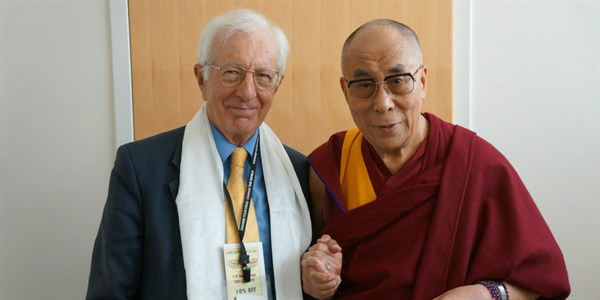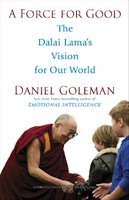What really matters for a happy and meaningful life?
08 Jul 2015 | Daniel Goleman
The following is an excerpt from Daniel Goleman's new book, A Force for Good: The Dalai Lama's Vision for Our
World.

"What's the source of happiness?" a student at Princeton
University asked the Dalai Lama.
Looking around at the students waiting for his answer, the Dalai
Lama paused a beat or two, then called out: "Money!"
Another beat or two: "Sex!"
And then: "Nightclubs!"
His joke brought down the house.
Then he went on to say that when we see the world through a
materialistic lens, we look to such sensory stimulation as the
source of satisfaction or joyfulness. But, he added, focusing only
on sensory delights leaves us perpetually dissatisfied, because
such pleasures are short-lived.
When I met with the Dalai Lama in Italy for this book, he had
just received an invitation to a conference on the nature of
happiness from Lord Richard Layard, whom my wife and I stopped
off to see the next week in his office at the London School of
Economics.
The aim of life, Layard told us, should be to create as much
happiness as we can - and as little misery - in the world around
us.
Layard and his allies sought to stir a supporting social change
that would offer an alternative to the predominant self-obsession
with financial striving. They wanted to spread a better vision of
what a happy, fulfilling life looks like.
And so began Action for Happiness, a secular
movement that captures much of the ways in which religion aims to
give people an ethical and emotional anchor -- teaching how to
engage life with meaning, and treat others well - but in a way that
also appeals to people with no particular religious interest. As a
sign of his endorsement, the Dalai Lama agreed to be the
organization's "patron".

[Action for Happiness co-founder Richard Layard with His Holiness
the Dalai Lama]
On joining Action for Happiness, people pledge: "I will try to
create more happiness and less unhappiness in the world around me."
That means taking action to improve their own wellbeing, but also
to help create happier neighborhoods, workplaces, schools and
communities, says Mark Williamson, the group's Director.
While Action for Happiness' membership numbers in the hundreds
of thousands, and about 60% of those live in farflung countries,
"The magic is in small, face-to-face groups," Williamson says. The
model seems a bit like Alcoholics Anonymous, in that anyone who
qualifies can initiate a local group where people meet together
regularly around a set format.
Each meeting starts with a few minutes of mindfulness and
expressions of gratitude, with the topic for discussion at the
heart of the session. The meeting ends with people choosing an
action to take, along the lines of helping someone in need or
connecting with a lonely person. One group launched a Happiness Cafe, where like-minded people can
connect and share ideas to create a happier and more supportive
local community.
In Exploring What Matters, the main Action
for Happiness program, groups meet for eight weeks, with each
session focusing on a big question for discussion. They start with
"What really matters in life?" and then "What really makes us
happy?". These are followed by sessions on dealing with adversity,
having good relationships, caring for others, and creating happier
workplaces and communities. They end with "How can we create a
happier world?"

[Animated discussions at an Action for Happiness event in
London]
This progression from personal meaning and happiness to
compassion often leads people to find ways to help other people.
For instance, Jasmine Hodge-Lake came to Action for Happiness
because of her chronic pain. Degenerative spine disease, carpal
tunnel, and fibromyalgia created a toxic mix of suffering that had
brought her life to a standstill.
Unable to work, and having been in constant pain for over a
decade, she spent her days in despair. A pain management course
that brought no relief left her feeling more helpless, plunging her
deeper into depression. "At the end I felt, I have no hope," said
Hodge-Lake. "This is my life: no life."
Adding to her funk, she felt isolated. "I didn't want to be
around other people and thought that no one really cared about me,"
she recalls.
By chance, she stumbled on the Action for Happiness website,
which includes a simple list of Ten Keys to
Happier Living - connecting more with people, for example. For
Hodge-Lake that list brought the realization there were practical
steps she could take to become happier. And so she joined the
eight-week course.
Her first "lightbulb" moment in the course came as she was
listening to a talk by Jon Kabat-Zinn about mindfulness and saw
that she could change her relationship to her pain: Accept it
rather than fight against it. That internal shift lessened her
emotional distress, even as the sensations of pain remained.
Another lightbulb came during the week on what makes work
meaningful and fulfilling. Hodge-Lake, realizing she had lost
passion for just about everything, resolved to work with other
people suffering from chronic pain, to see how she might help them
too.
"I was still fairly depressed, but I started to do more things,"
Hodge-Lake said. "It was amazing how the tools that Action for
Happiness gave me helped. I found there were things I could do that
would make a big difference. I started to feel hopeful about the
future."
With that inner change, she thought about how to improve support
for people who live with chronic pain. "I realized we need a new
approach - one that is more hopeful and uses some of the ideas that
I had learned from Action for Happiness."
Hodge-Lake now informally counsels others with chronic pain
about ways they might be helped - and she seeks to give them hope.
She's in the process of becoming a "patient voice" in a program to
improve patient-care guidelines for Britain's medical system. And
she's spreading the word about Action for Happiness, passing out
their card on Ten Keys to Happier Living - and encouraging people
to get involved.
"I wouldn't be where I am now without Action for Happiness and
that course," she contends. "I still have bad days and life
certainly isn't perfect. But it has really helped me so much. Now
I'm trying to be the change that I want to see."
---
In A Force for Good, with the
help of his longtime friend Daniel Goleman, the New York Times
bestselling author of Emotional Intelligence, the Dalai Lama
explains how to turn our compassionate energy outward. This
revelatory and inspiring work provides a singular vision for
transforming the world in practical and positive ways.

